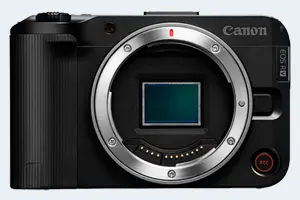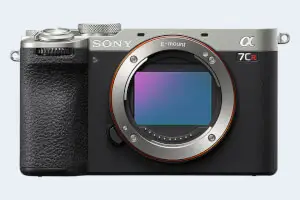Canon R50 V vs Sony A7C R
The Canon EOS R50 V and the Sony Alpha A7C R are two digital cameras that were revealed to the public, respectively, in March 2025 and August 2023. Both the R50 V and the A7C R are mirrorless interchangeable lens cameras that are based on an APS-C (R50 V) and a full frame (A7C R) sensor. The Canon has a resolution of 24 megapixels, whereas the Sony provides 60.2 MP.
Below is an overview of the main specs of the two cameras as a starting point for the comparison.

Check R50 V price at
amazon.com

Check A7C R price at
amazon.com
Going beyond this snapshot of core features and characteristics, what are the differences between the Canon EOS R50 V and the Sony Alpha A7C R? Which one should you buy? Read on to find out how these two cameras compare with respect to their body size, their imaging sensors, their shooting features, their input-output connections, and their reception by expert reviewers.
Body comparison
The physical size and weight of the Canon R50 V and the Sony A7C R are illustrated in the side-by-side display below. The two cameras are presented according to their relative size. Three consecutive views from the front, the top, and the rear side are shown. All size dimensions are rounded to the nearest millimeter.
The A7C R can be obtained in two different colors (black, silver), while the R50 V is only available in black.
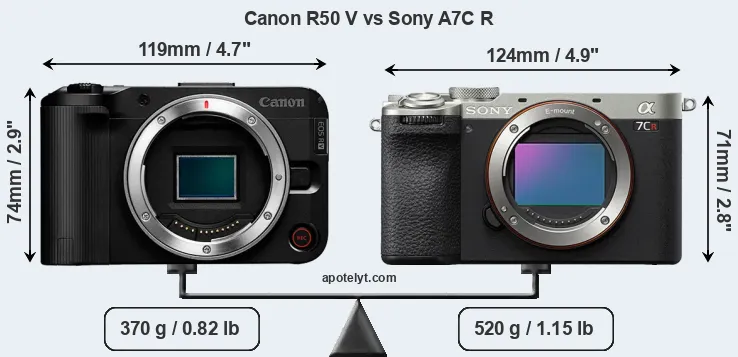

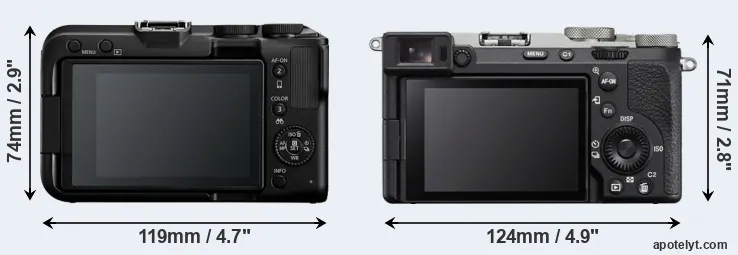
If the front view area (width x height) of the cameras is taken as an aggregate measure of their size, the Canon R50 V and the Sony A7C R are of equal size. However, the A7C R is substantially heavier (41 percent) than the R50 V. It is noteworthy in this context that the A7C R is splash and dust-proof, while the R50 V does not feature any corresponding weather-sealing.
The above size and weight comparisons are to some extent incomplete since they do not consider the interchangeable lenses that both of these cameras require. Hence, you might want to study and compare the specifications of available lenses in order to get the full picture of the size and weight of the two camera systems.
Concerning battery life, the R50 V gets 390 shots out of its Canon LP-E17 battery, while the A7C R can take 520 images on a single charge of its Sony NP-FZ100 power pack. The battery packs of both cameras can be charged via USB, which can be very convenient when travelling.
The adjacent table lists the principal physical characteristics of the two cameras alongside a wider set of alternatives. If you would like to visualize and compare a different camera combination, you can navigate to the CAM-parator app and make your selection from a broad list of cameras there.

| Camera Model |
Camera Width |
Camera Height |
Camera Depth |
Camera Weight |
Battery Life |
Weather Sealing |
Camera Launch |
Launch Price |
Street Price |
||
|---|---|---|---|---|---|---|---|---|---|---|---|
| 1. | Canon R50 V | 119 mm | 74 mm | 45 mm | 370 g | 390 | n | Mar 2025 | US$ 649 | amazon.com | |
| 2. | Sony A7C R | 124 mm | 71 mm | 63 mm | 520 g | 520 | Y | Aug 2023 | US$ 2 999 | amazon.com | |
| 3. | Canon M3 | 111 mm | 68 mm | 44 mm | 366 g | 250 | n | Feb 2015 | US$ 679 | ebay.com | |
| 4. | Canon M6 | 112 mm | 68 mm | 45 mm | 390 g | 295 | n | Feb 2017 | US$ 779 | ebay.com | |
| 5. | Canon M50 | 116 mm | 88 mm | 59 mm | 390 g | 235 | n | Feb 2018 | US$ 779 | ebay.com | |
| 6. | Canon M50 Mark II | 116 mm | 88 mm | 59 mm | 387 g | 305 | n | Oct 2020 | US$ 599 | ebay.com | |
| 7. | Canon R10 | 123 mm | 88 mm | 83 mm | 429 g | 450 | n | May 2022 | US$ 979 | amazon.com | |
| 8. | Canon R50 | 116 mm | 86 mm | 69 mm | 375 g | 230 | n | Feb 2023 | US$ 679 | amazon.com | |
| 9. | Canon R100 | 116 mm | 86 mm | 69 mm | 356 g | 400 | n | May 2023 | US$ 479 | amazon.com | |
| 10. | Canon SL2 | 122 mm | 93 mm | 70 mm | 453 g | 650 | n | Jun 2017 | US$ 549 | ebay.com | |
| 11. | Canon SL3 | 122 mm | 93 mm | 70 mm | 449 g | 1070 | n | Apr 2019 | US$ 599 | amazon.com | |
| 12. | Canon V1 | 118 mm | 68 mm | 53 mm | 426 g | 340 | n | Feb 2025 | US$ 899 | amazon.com | |
| 13. | Sony A7R II | 127 mm | 96 mm | 60 mm | 625 g | 290 | Y | Jun 2015 | US$ 3 199 | ebay.com | |
| 14. | Sony A7R IV | 129 mm | 96 mm | 78 mm | 665 g | 670 | Y | Jul 2019 | US$ 3 499 | ebay.com | |
| 15. | Sony A7R V | 131 mm | 97 mm | 82 mm | 723 g | 530 | Y | Oct 2022 | US$ 3 899 | amazon.com | |
| 16. | Sony A7S II | 127 mm | 96 mm | 60 mm | 627 g | 370 | Y | Sep 2015 | US$ 2 999 | ebay.com | |
| 17. | Sony ZV-E1 | 121 mm | 72 mm | 54 mm | 483 g | 570 | Y | Mar 2023 | US$ 2 199 | amazon.com | |
| Note: Measurements and pricing do not include easily detachable parts, such as add-on or interchangeable lenses or optional viewfinders. | |||||||||||
Any camera decision will obviously take relative prices into account. The manufacturer’s suggested retail prices give an idea on the placement of the camera in the maker’s lineup and the broader market. The R50 V was launched at a markedly lower price (by 78 percent) than the A7C R, which puts it into a different market segment. Usually, retail prices stay at first close to the launch price, but after several months, discounts become available. Later in the product cycle and, in particular, when the replacement model is about to appear, further discounting and stock clearance sales often push the camera price considerably down. Then, after the new model is out, very good deals can frequently be found on the pre-owned market.
Sensor comparison
The size of the sensor inside a digital camera is one of the key determinants of image quality. All other things equal, a large sensor will have larger individual pixel-units that offer better low-light sensitivity, wider dynamic range, and richer color-depth than smaller pixels in a sensor of the same technological generation. Moreover, a large sensor camera will give the photographer more control over depth-of-field in the image and, thus, the ability to better isolate a subject from the background. On the downside, larger sensors tend to be more expensive and lead to bigger and heavier cameras and lenses.
Of the two cameras under consideration, the Canon R50 V features an APS-C sensor and the Sony A7C R a full frame sensor. The sensor area in the A7C R is 156 percent bigger. As a result of these sensor size differences, the cameras have a format factor of, respectively, 1.6 and 1.0. Both cameras have a native aspect ratio (sensor width to sensor height) of 3:2.
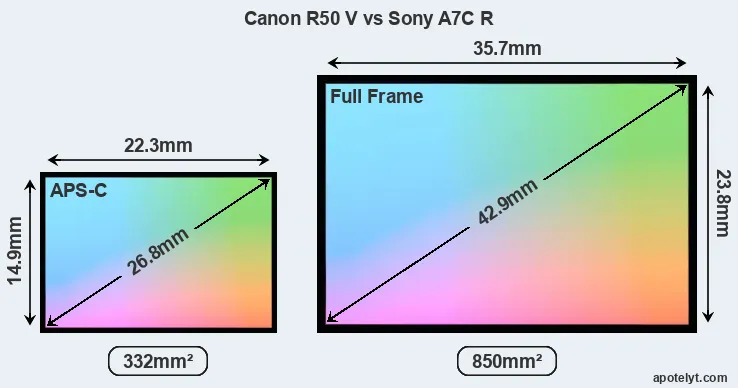
With 60.2MP, the A7C R offers a higher resolution than the R50 V (24MP), but the A7C R nevertheless has marginally larger individual pixels (pixel pitch of 3.76μm versus 3.72μm for the R50 V) due to its larger sensor. However, the R50 V is a somewhat more recent model (by 1 year and 6 months) than the A7C R, and its sensor might have benefitted from technological advances during this time that enhance the light gathering capacity of its pixel-units. Coming back to sensor resolution, it should be mentioned that the A7C R has no anti-alias filter installed, so that it can capture all the detail its sensor resolves.
The resolution advantage of the Sony A7C R implies greater flexibility for cropping images or the possibility to print larger pictures. The maximum print size of the A7C R for good quality output (200 dots per inch) amounts to 47.5 x 31.7 inches or 120.7 x 80.5 cm, for very good quality (250 dpi) 38 x 25.3 inches or 96.6 x 64.4 cm, and for excellent quality (300 dpi) 31.7 x 21.1 inches or 80.5 x 53.6 cm. The corresponding values for the Canon R50 V are 30 x 20 inches or 76.2 x 50.8 cm for good quality, 24 x 16 inches or 61 x 40.6 cm for very good quality, and 20 x 13.3 inches or 50.8 x 33.9 cm for excellent quality prints.
Unlike the R50 V, the A7C R has the capacity to capture high quality composite images (240MP) by combining multiple shots after shifting its sensor by miniscule distances. This multi-shot, pixel-shift mode is most suitable for photography of stationary objects (landscapes, studio scenes).
The Canon EOS R50 V has a native sensitivity range from ISO 100 to ISO 32000, which can be extended to ISO 100-51200. The corresponding ISO settings for the Sony Alpha A7C R are ISO 100 to ISO 32000, with the possibility to increase the ISO range to 50-102400.
In terms of underlying technology, the R50 V is build around a CMOS sensor, while the A7C R uses a BSI-CMOS imager. Both cameras use a Bayer filter for capturing RGB colors on a square grid of photosensors. This arrangement is found in most digital cameras.
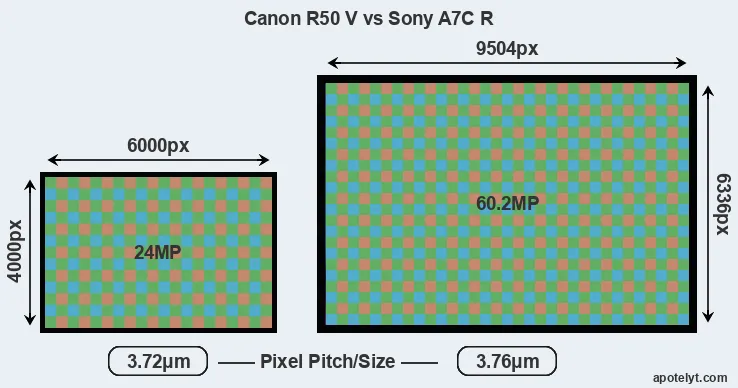
For many cameras, data on sensor performance has been reported by DXO Mark. This service is based on lab testing and assigns an overall score to each camera sensor, as well as ratings for dynamic range ("DXO Landscape"), color depth ("DXO Portrait"), and low-light sensitivity ("DXO Sports"). The following table provides an overview of the physical sensor characteristics, as well as the sensor quality measurements for a selection of comparators.

| Camera Model |
Sensor Class |
Resolution (MP) |
Horiz. Pixels |
Vert. Pixels |
Video Format |
DXO Portrait |
DXO Landscape |
DXO Sports |
DXO Overall |
||
|---|---|---|---|---|---|---|---|---|---|---|---|
| 1. | Canon R50 V | APS-C | 24.0 | 6000 | 4000 | 4K/60p | 24.1 | 14.1 | 2383 | 85 | |
| 2. | Sony A7C R | Full Frame | 60.2 | 9504 | 6336 | 4K/60p | 25.4 | 14.7 | 3227 | 96 | |
| 3. | Canon M3 | APS-C | 24.0 | 6000 | 4000 | 1080/30p | 22.8 | 11.8 | 1169 | 72 | |
| 4. | Canon M6 | APS-C | 24.0 | 6000 | 4000 | 1080/60p | 23.4 | 12.6 | 1317 | 78 | |
| 5. | Canon M50 | APS-C | 24.0 | 6000 | 4000 | 4K/24p | 23.8 | 13.3 | 1684 | 81 | |
| 6. | Canon M50 Mark II | APS-C | 24.0 | 6000 | 4000 | 4K/24p | 24.0 | 13.6 | 1939 | 83 | |
| 7. | Canon R10 | APS-C | 24.0 | 6000 | 4000 | 4k/60p | 24.1 | 13.8 | 2085 | 84 | |
| 8. | Canon R50 | APS-C | 24.0 | 6000 | 4000 | 4K/30p | 24.1 | 13.9 | 2168 | 84 | |
| 9. | Canon R100 | APS-C | 24.0 | 6000 | 4000 | 4k/24p | 24.1 | 13.9 | 2197 | 84 | |
| 10. | Canon SL2 | APS-C | 24.0 | 6000 | 4000 | 1080/60p | 23.6 | 13.4 | 1041 | 79 | |
| 11. | Canon SL3 | APS-C | 24.0 | 6000 | 4000 | 4K/25p | 23.9 | 13.4 | 1791 | 82 | |
| 12. | Canon V1 | APS-C | 22.1 | 5750 | 3840 | 4K/60p | 23.5 | 13.7 | 1911 | 79 | |
| 13. | Sony A7R II | Full Frame | 42.2 | 7952 | 5304 | 4K/30p | 26.0 | 13.9 | 3434 | 98 | |
| 14. | Sony A7R IV | Full Frame | 60.2 | 9504 | 6336 | 4K/30p | 26.0 | 14.8 | 3344 | 99 | |
| 15. | Sony A7R V | Full Frame | 60.2 | 9504 | 6336 | 8k/24p | 26.5 | 14.8 | 3187 | 100 | |
| 16. | Sony A7S II | Full Frame | 12.0 | 4240 | 2832 | 4K/30p | 23.6 | 13.3 | 2993 | 85 | |
| 17. | Sony ZV-E1 | Full Frame | 12.0 | 4240 | 2832 | 4K/60p | 25.4 | 14.6 | 3181 | 96 | |
| Note: DXO values in italics represent estimates based on sensor size and age. | |||||||||||
Many modern cameras cannot only take still pictures, but also record videos. Both cameras under consideration are equipped with sensors that have a sufficiently high read-out speed for moving images, and both provide the same movie specifications (4K/60p).
Feature comparison
Apart from body and sensor, cameras can and do differ across a variety of features. For example, the A7C R has an electronic viewfinder (2360k dots), which can be very helpful when shooting in bright sunlight. In contrast, the R50 V relies on live view and the rear LCD for framing. The table below summarizes some of the other core capabilities of the Canon R50 V and Sony A7C R in connection with corresponding information for a sample of similar cameras.

| Camera Model |
Viewfinder (Type or 000 dots) |
Control Panel (yes/no) |
LCD Specifications (inch/000 dots) |
LCD Attach- ment |
Touch Screen (yes/no) |
Max Shutter Speed * |
Max Shutter Flaps * |
Built-in Flash (yes/no) |
Built-in Image Stab |
||
|---|---|---|---|---|---|---|---|---|---|---|---|
| 1. | Canon R50 V | none | n | 3.0 / 1040 | swivel | Y | 1/4000s | 12.0/s | n | n | |
| 2. | Sony A7C R | 2360 | n | 3.0 / 1037 | swivel | Y | 1/4000s | 8.0/s | n | Y | |
| 3. | Canon M3 | optional | n | 3.0 / 1040 | tilting | Y | 1/4000s | 4.2/s | Y | n | |
| 4. | Canon M6 | optional | n | 3.0 / 1040 | tilting | Y | 1/4000s | 9.0/s | Y | n | |
| 5. | Canon M50 | 2360 | n | 3.0 / 1040 | swivel | Y | 1/4000s | 10.0/s | Y | n | |
| 6. | Canon M50 Mark II | 2360 | n | 3.0 / 1040 | swivel | Y | 1/4000s | 10.0/s | Y | n | |
| 7. | Canon R10 | 2360 | n | 3.0 / 1040 | swivel | Y | 1/8000s | 15.0/s | Y | n | |
| 8. | Canon R50 | 2360 | n | 3.0 / 1620 | swivel | Y | 1/4000s | 12.0/s | Y | n | |
| 9. | Canon R100 | 2360 | n | 3.0 / 1040 | fixed | n | 1/4000s | 6.5/s | Y | n | |
| 10. | Canon SL2 | optical | n | 3.0 / 1040 | swivel | Y | 1/4000s | 5.0/s | Y | n | |
| 11. | Canon SL3 | optical | n | 3.0 / 1040 | swivel | Y | 1/4000s | 5.0/s | Y | n | |
| 12. | Canon V1 | none | n | 3.0 / 1040 | swivel | Y | 1/2000s | 30.0/s | n | n | |
| 13. | Sony A7R II | 2400 | n | 3.0 / 1229 | tilting | n | 1/8000s | 5.0/s | n | Y | |
| 14. | Sony A7R IV | 5760 | n | 3.0 / 1440 | tilting | Y | 1/8000s | 10.0/s | n | Y | |
| 15. | Sony A7R V | 9440 | n | 3.2 / 2100 | full-flex | Y | 1/8000s | 10.0/s | n | Y | |
| 16. | Sony A7S II | 2400 | n | 3.0 / 1229 | tilting | n | 1/8000s | 5.0/s | n | Y | |
| 17. | Sony ZV-E1 | none | n | 3.0 / 1037 | swivel | Y | 1/8000s | 10.0/s | n | Y | |
| Note: *) Information refers to the mechanical shutter, unless the camera only has an electronic one. | |||||||||||
One feature that differentiates the A7C R and the R50 V is in-body image stabilization (IBIS). The A7C R reduces the risk of handshake-induced blur with all attached lenses, while the R50 V offers no blur reduction with lenses that themselves do not provide optical image stabilization.
Both cameras have an articulated rear screen that can be turned to be front-facing. This feature will be particularly appreciated by vloggers and photographers who are interested in taking selfies.The reported shutter speed information refers to the use of the mechanical shutter. Yet, some cameras only have an electronic shutter, while others have an electronic shutter in addition to a mechanical one. In fact, both cameras under consideration feature an electronic shutter, which makes completely silent shooting possible. However, this mode is less suitable for photographing moving objects (risk of rolling shutter) or shooting under artificial light sources (risk of flickering).
The Canon R50 V and the Sony A7C R both have an intervalometer built-in. This enables the photographer to capture time lapse sequences, such as flower blooming, a sunset or moon rise, without purchasing an external camera trigger and related software.
The R50 V writes its imaging data to SDXC cards, while the A7C R uses SDXC or Memory Stick PRO Duo cards.
Connectivity comparison
For some imaging applications, the extent to which a camera can communicate with its environment can be an important aspect in the camera decision process. The table below provides an overview of the connectivity of the Canon EOS R50 V and Sony Alpha A7C R and, in particular, the interfaces the cameras (and selected comparators) provide for accessory control and data transfer.

| Camera Model |
Hotshoe Port |
Internal Mic / Speaker |
Microphone Port |
Headphone Port |
HDMI Port |
USB Port |
WiFi Support |
NFC Support |
Bluetooth Support |
||
|---|---|---|---|---|---|---|---|---|---|---|---|
| 1. | Canon R50 V | Y | stereo / mono | Y | Y | micro | 3.2 | Y | - | Y | |
| 2. | Sony A7C R | Y | stereo / mono | Y | Y | micro | 3.2 | Y | - | Y | |
| 3. | Canon M3 | Y | stereo / mono | Y | - | mini | 2.0 | Y | Y | - | |
| 4. | Canon M6 | Y | stereo / mono | Y | - | mini | 2.0 | Y | Y | Y | |
| 5. | Canon M50 | Y | stereo / mono | Y | - | micro | 2.0 | Y | - | Y | |
| 6. | Canon M50 Mark II | Y | stereo / mono | Y | - | micro | 2.0 | Y | - | Y | |
| 7. | Canon R10 | Y | stereo / mono | Y | - | micro | 2.0 | Y | - | Y | |
| 8. | Canon R50 | Y | stereo / mono | Y | - | micro | 3.2 | Y | - | Y | |
| 9. | Canon R100 | Y | stereo / mono | Y | - | micro | 2.0 | Y | - | Y | |
| 10. | Canon SL2 | Y | stereo / mono | Y | - | mini | 2.0 | Y | Y | Y | |
| 11. | Canon SL3 | Y | stereo / mono | Y | - | mini | 2.0 | Y | - | Y | |
| 12. | Canon V1 | Y | stereo / mono | Y | Y | micro | 2.0 | Y | - | Y | |
| 13. | Sony A7R II | Y | stereo / mono | Y | Y | micro | 2.0 | Y | Y | - | |
| 14. | Sony A7R IV | Y | stereo / mono | Y | Y | micro | 3.1 | Y | Y | Y | |
| 15. | Sony A7R V | Y | stereo / mono | Y | Y | full | 3.2 | Y | - | Y | |
| 16. | Sony A7S II | Y | stereo / mono | Y | Y | micro | 2.0 | Y | Y | - | |
| 17. | Sony ZV-E1 | Y | stereo / mono | Y | Y | micro | 3.2 | Y | - | Y |
Both the R50 V and the A7C R are recent models that are part of the current product line-up. Neither of the two has a direct predecessor, so perhaps they will constitute the origins of new camera lines for Canon and Sony. Further information on the two cameras (e.g. user guides, manuals), as well as related accessories, can be found on the official Canon and Sony websites.
Review summary
So what conclusions can be drawn? Which of the two cameras – the Canon R50 V or the Sony A7C R – has the upper hand? Is one clearly better than the other? Below is a summary of the relative strengths of each of the two contestants.

Advantages of the Canon EOS R50 V:
- Better moiré control: Has an anti-alias filter to avoid artificial patterns to appear in images.
- Faster burst: Shoots at higher frequency (12 vs 8 flaps/sec) to capture the decisive moment.
- Less heavy: Is lighter (by 150g or 29 percent) and hence easier to carry around.
- More affordable: Was introduced into a lower priced category (78 percent cheaper at launch).
- More modern: Is somewhat more recent (announced 1 year and 6 months after the A7C R).

Reasons to prefer the Sony Alpha A7C R:
- More detail: Has more megapixels (60.2 vs 24MP), which boosts linear resolution by 58%.
- Maximized detail: Lacks an anti-alias filter to exploit the sensor's full resolution potential.
- High quality composites: Can combine several shots after pixel-shifting its sensor.
- Better image quality: Features bigger pixels on a larger sensor for higher quality imaging.
- Richer colors: The pixel size advantage translates into images with better, more accurate colors.
- More dynamic range: Larger pixels capture a wider spectrum of light and dark details.
- Better low-light sensitivity: Larger pixels means good image quality even under poor lighting.
- Easier framing: Has an electronic viewfinder for image composition and settings control.
- Longer lasting: Gets more shots (520 versus 390) out of a single battery charge.
- Better sealing: Is splash and dust sealed for shooting in inclement weather conditions.
- Sharper images: Has stabilization technology built-in to reduce the impact of hand-shake.
- More heavily discounted: Has been on the market for longer (launched in August 2023).
If the count of relative strengths (bullet points above) is taken as a measure, the A7C R is the clear winner of the contest (12 : 5 points). However, the relevance of individual strengths will vary across photographers, so that you might want to apply your own weighing scheme to the summary points when reflecting and deciding on a new camera. A professional wedding photographer will view the differences between cameras in a way that diverges from the perspective of a travel photog, and a person interested in cityscapes has distinct needs from a macro shooter. Hence, the decision which camera is best and worth buying is often a very personal one.
How about other alternatives? Do the specifications of the Canon R50 V and the Sony A7C R place the cameras among the top in their class? Find out in the latest Best Mirrorless Interchangeable Lens Camera listing whether the two cameras rank among the cream of the crop.
In any case, while the specs-based evaluation of cameras can be instructive in revealing their potential as photographic tools, it remains incomplete and does no justice, for example, to the way the R50 V or the A7C R perform in practice. At times, user reviews, such as those published at amazon, address these issues in a useful manner, but such feedback is on many occasions incomplete, inconsistent, and unreliable.
Expert reviews
This is where reviews by experts come in. The table below provides a synthesis of the camera assessments of some of the best known photo-gear review sites (amateurphotographer [AP], cameralabs [CL], digitalcameraworld [DCW], dpreview [DPR], ephotozine [EPZ], photographyblog [PB]). As can be seen, the professional reviewers agree in many cases on the quality of different cameras, but sometimes their assessments diverge, reinforcing the earlier point that a camera decision is often a very personal choice.

| Camera Model |
AP score |
CL score |
DCW score |
DPR score |
EPZ score |
PB score |
Camera Launch |
Launch Price |
Street Price |
||
|---|---|---|---|---|---|---|---|---|---|---|---|
| 1. | Canon R50 V | .. | .. | .. | 84/100 | .. | .. | Mar 2025 | US$ 649 | amazon.com | |
| 2. | Sony A7C R | 4/5 | .. | 4/5 | 88/100 | .. | 4/5 | Aug 2023 | US$ 2 999 | amazon.com | |
| 3. | Canon M3 | 4/5 | o | .. | 75/100 | 4.5/5 | 4/5 | Feb 2015 | US$ 679 | ebay.com | |
| 4. | Canon M6 | .. | .. | .. | 80/100 | 4/5 | 4/5 | Feb 2017 | US$ 779 | ebay.com | |
| 5. | Canon M50 | .. | + | 4/5 | 79/100 | .. | 3.5/5 | Feb 2018 | US$ 779 | ebay.com | |
| 6. | Canon M50 Mark II | 4/5 | .. | 4/5 | .. | 4.5/5 | 3.5/5 | Oct 2020 | US$ 599 | ebay.com | |
| 7. | Canon R10 | 4/5 | .. | 4.5/5 | 87/100 | 4/5 | 4.5/5 | May 2022 | US$ 979 | amazon.com | |
| 8. | Canon R50 | 4/5 | + + | 4.5/5 | 84/100 | .. | 4.5/5 | Feb 2023 | US$ 679 | amazon.com | |
| 9. | Canon R100 | 3/5 | o | 4.5/5 | 79/100 | .. | 3.5/5 | May 2023 | US$ 479 | amazon.com | |
| 10. | Canon SL2 | 4/5 | + + | 4/5 | 78/100 | 4.5/5 | 4.5/5 | Jun 2017 | US$ 549 | ebay.com | |
| 11. | Canon SL3 | 4/5 | o | 4.5/5 | 79/100 | 4/5 | 4/5 | Apr 2019 | US$ 599 | amazon.com | |
| 12. | Canon V1 | .. | .. | .. | 84/100 | .. | .. | Feb 2025 | US$ 899 | amazon.com | |
| 13. | Sony A7R II | 5/5 | + + | 5/5 | 90/100 | 5/5 | 5/5 | Jun 2015 | US$ 3 199 | ebay.com | |
| 14. | Sony A7R IV | 5/5 | + | 4.5/5 | 91/100 | 4.5/5 | 5/5 | Jul 2019 | US$ 3 499 | ebay.com | |
| 15. | Sony A7R V | 5/5 | + + | 4.5/5 | 92/100 | .. | .. | Oct 2022 | US$ 3 899 | amazon.com | |
| 16. | Sony A7S II | 5/5 | + | .. | .. | 4.5/5 | 5/5 | Sep 2015 | US$ 2 999 | ebay.com | |
| 17. | Sony ZV-E1 | .. | + | 4/5 | .. | .. | 4.5/5 | Mar 2023 | US$ 2 199 | amazon.com | |
| Note: (+ +) highly recommended; (+) recommended; (o) reviewed; (..) not available. | |||||||||||
The review scores listed above should be treated with care, though. The ratings were established in reference to similarly priced cameras that were available in the market at the time of the review. Hence, a score should always be seen in the context of the camera's market launch date and its price, and comparisons of ratings among very different cameras or across long time periods have little meaning. Also, kindly note that some of the listed sites have over time developped their review approaches and their reporting style.

Check R50 V price at
amazon.com

Check A7C R price at
amazon.com
Other camera comparisons
Did this review help to inform your camera decision process? In case you would like to check on the differences and similarities of other camera models, just use the search menu below. As an alternative, you can also directly jump to any one of the listed comparisons that were previously generated by the CAM-parator tool.
- Canon M200 vs Sony A7C R
- Canon R50 V vs Canon R8
- Canon R50 V vs Fujifilm X-H2
- Canon R50 V vs Leica SL3
- Canon R50 V vs Panasonic GX80
- Canon R50 V vs Pentax WG-90
- Canon R50 V vs Sony ZV-1 II
- Leica M11 vs Sony A7C R
- Nikon Z6 vs Sony A7C R
- Panasonic S1 vs Sony A7C R
- Pentax WG-1000 vs Sony A7C R
- Sony A1 II vs Sony A7C R
Specifications: Canon R50 V vs Sony A7C R
Below is a side-by-side comparison of the specs of the two cameras to facilitate a quick review of their differences and common features.
| Camera Model | Canon R50 V | Sony A7C R |
|---|---|---|
| Camera Type | Mirrorless system camera | Mirrorless system camera |
| Camera Lens | Canon RF mount lenses | Sony E mount lenses |
| Launch Date | March 2025 | August 2023 |
| Launch Price | USD 649 | USD 2,999 |
| Sensor Specs | Canon R50 V | Sony A7C R |
| Sensor Technology | CMOS | BSI-CMOS |
| Sensor Format | APS-C Sensor | Full Frame Sensor |
| Sensor Size | 22.3 x 14.9 mm | 35.7 x 23.8 mm |
| Sensor Area | 332.27 mm2 | 849.66 mm2 |
| Sensor Diagonal | 26.8 mm | 42.9 mm |
| Crop Factor | 1.6x | 1.0x |
| Sensor Resolution | 24 Megapixels | 60.2 Megapixels |
| Image Resolution | 6000 x 4000 pixels | 9504 x 6336 pixels |
| Pixel Pitch | 3.72 μm | 3.76 μm |
| Pixel Density | 7.22 MP/cm2 | 7.09 MP/cm2 |
| Moiré control | Anti-Alias filter | no AA filter |
| Movie Capability | 4K/60p Video | 4K/60p Video |
| ISO Setting | 100 - 32,000 ISO | 100 - 32,000 ISO |
| ISO Boost | 100 - 51,200 ISO | 50 - 102,400 ISO |
| Image Processor | DIGIC X | BIONZ XR |
| Screen Specs | Canon R50 V | Sony A7C R |
| Viewfinder Type | no viewfinder | Electronic viewfinder |
| Viewfinder Field of View | 100% | |
| Viewfinder Magnification | 0.7x | |
| Viewfinder Resolution | 2360k dots | |
| LCD Framing | Live View | Live View |
| Rear LCD Size | 3.0inch | 3.0inch |
| LCD Resolution | 1040k dots | 1037k dots |
| LCD Attachment | Swivel screen | Swivel screen |
| Touch Input | Touchscreen | Touchscreen |
| Shooting Specs | Canon R50 V | Sony A7C R |
| Focus System | On-Sensor Phase-detect | On-Sensor Phase-detect |
| Manual Focusing Aid | Focus Peaking | Focus Peaking |
| Max Shutter Speed (mechanical) | 1/4000s | 1/4000s |
| Continuous Shooting | 12 shutter flaps/s | 8 shutter flaps/s |
| Electronic Shutter | up to 1/8000s | up to 1/8000s |
| Time-Lapse Photography | Intervalometer built-in | Intervalometer built-in |
| Image Stabilization | Lens stabilization only | In-body stabilization |
| Fill Flash | no On-Board Flash | no On-Board Flash |
| Storage Medium | SDXC cards | MS or SDXC cards |
| Single or Dual Card Slots | Single card slot | Single card slot |
| UHS card support | UJH-II | UHS-II |
| Connectivity Specs | Canon R50 V | Sony A7C R |
| External Flash | Hotshoe | Hotshoe |
| USB Connector | USB 3.2 | USB 3.2 |
| HDMI Port | micro HDMI | micro HDMI |
| Microphone Port | External MIC port | External MIC port |
| Headphone Socket | Headphone port | Headphone port |
| Wifi Support | Wifi built-in | Wifi built-in |
| Bluetooth Support | Bluetooth built-in | Bluetooth built-in |
| Body Specs | Canon R50 V | Sony A7C R |
| Environmental Sealing | not weather sealed | Weathersealed body |
| Battery Type | Canon LP-E17 | Sony NP-FZ100 |
| Battery Life (CIPA) | 390 shots per charge | 520 shots per charge |
| In-Camera Charging | USB charging | USB charging |
| Body Dimensions |
119 x 74 x 45 mm (4.7 x 2.9 x 1.8 in) |
124 x 71 x 63 mm (4.9 x 2.8 x 2.5 in) |
| Camera Weight | 370 g (13.1 oz) | 520 g (18.3 oz) |

Check R50 V price at
amazon.com

Check A7C R price at
amazon.com
Did you notice an error on this page? If so, please get in touch, so that we can correct the information.
